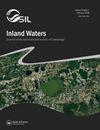加拿大埃洛迪亚在其原生和入侵范围内的水生无脊椎动物群落结构
IF 2.3
3区 环境科学与生态学
Q1 LIMNOLOGY
引用次数: 0
摘要
入侵物种是一个全球性问题,影响着整个生态系统的生物多样性、群落结构和生态功能。加拿大水草是一种水下水生大型植物,原产于加拿大南部和美国48个相邻地区,但在阿拉斯加入侵。本研究的目的是比较本地(伊利诺伊州)和入侵(阿拉斯加)地区与加拿大绿叶蝉相关的水生大型无脊椎动物群落。大型无脊椎动物在入侵地和本土地的功能摄食群群落结构存在差异。收集者-过滤器相对丰度在入侵区较高,而捕食者-吞噬者相对丰度在本土区较高。此外,加拿大野田鼠床的碎草食动物密度在本土地高于入侵地。研究结果表明,加拿大绿叶蝉在阿拉斯加的成功建立可能是由于其食草性的减少,而加拿大绿叶蝉的持续传播将改变阿拉斯加铜河三角洲的生态系统结构和功能,以及它所提供的生态系统服务。本文章由计算机程序翻译,如有差异,请以英文原文为准。
Community structure of aquatic invertebrates associated with Elodea canadensis in its native and invasive range
ABSTRACT Invasive species are a global concern impacting biodiversity, community structure, and ecological function of entire ecosystems. Elodea canadensis (Canadian waterweed) is a submerged aquatic macrophyte native to southern Canada and the 48 contiguous United States but invasive in Alaska. The purpose of our study was to compare aquatic macroinvertebrate communities associated with E. canadensis in native (Illinois) and invasive (Alaska) areas. Functional feeding group community structure of E. canadensis-associated macroinvertebrates was different in the invasive and native range. Collector-filterer relative abundance was higher in the invasive range, whereas predator-engulfer relative abundance was higher in the native range. Furthermore, shredder-herbivore density in E. canadensis beds was higher in the native range than in the invasive range. Our results suggest that the successful establishment of E. canadensis in Alaska is likely facilitated by reduced herbivory and that the continued spread of E. canadensis will alter ecosystem structure and function of the Copper River Delta, Alaska, and the ecosystem services it provides.
求助全文
通过发布文献求助,成功后即可免费获取论文全文。
去求助
来源期刊

Inland Waters
LIMNOLOGY-MARINE & FRESHWATER BIOLOGY
CiteScore
6.10
自引率
9.70%
发文量
34
审稿时长
>12 weeks
期刊介绍:
Inland Waters is the peer-reviewed, scholarly outlet for original papers that advance science within the framework of the International Society of Limnology (SIL). The journal promotes understanding of inland aquatic ecosystems and their management. Subject matter parallels the content of SIL Congresses, and submissions based on presentations are encouraged.
All aspects of physical, chemical, and biological limnology are appropriate, as are papers on applied and regional limnology. The journal also aims to publish articles resulting from plenary lectures presented at SIL Congresses and occasional synthesis articles, as well as issues dedicated to a particular theme, specific water body, or aquatic ecosystem in a geographical area. Publication in the journal is not restricted to SIL members.
 求助内容:
求助内容: 应助结果提醒方式:
应助结果提醒方式:


